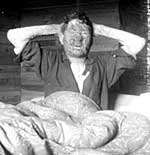By Mary Losure
Minnesota Public Radio
November 26, 2001
Philip D. Jordan's The People's Health: A History of Public Health in Minnesota to 1948, published in 1953 by the Minnesota Historical Society, contains detailed descriptions of the smallpox epidemics that spread through north woods lumber camps beginning in the 1870s. Jordan writes of one such outbreak.
| |
|
|
|
||
"Late in December, 1882, came the first startling news that epidemic smallpox had broken out at Caldwell's Camp between Grand Rapids and Leech Lake. A few days later a logger from that camp died at Grand Rapids."
Soon smallpox patients were arriving in Duluth for treatment, and "Brainerd's mayor sent a frantic message to Minneapolis city officials that 'panic-stricken' lumbermen were leaving the camps and heading toward the Twin Cities. Brainerd police were attempting to stop these runaways," Jordan writes.
Health officials appointed special deputy sheriffs to keep exposed loggers in camp and to help doctors vaccinate them. Health officials were advised to keep sick men together and burn the camps they had used. "Use every means to quiet the fear of the disease among men, telling them you represent the executive officer of the State board for their protection from infection and for their care, if sick. Prevent panic and instruct your assistants to do so too," the officers' instructions read.
"The epidemic of 1883, although it was not the first nor the last to occur in the pineries, was of particular health significance because it emphasized the unsanitary conditions of the logging camps. (It) proved the imperative need for vaccination among lumberjacks, because it demonstrated the difficulty of providing adequate care once an epidemic had broken out, and because it showed graphically the health relationship between logging areas and other communities," Jordan writes. "Both Minneapolis and Duluth reported small outbreaks as the result of infections brought from the camps on the upper Mississippi."
The next year, the State Health Department sent an open letter to the lumber industry urging vaccination of all employees, but it had little effect. "Many loggers could not see the necessity of having their arms scratched, and many lumber companies, desperately needing timber crews, felt they could not hire only men who had been vaccinated. And the state of Minnesota had no law making vaccination compulsory for either children or adults," Jorden writes.
For years afterward, the State Board of Health pressed unsuccessfully for better measures to fight smallpox in the lumber camps.
"There was a neat way, however, to force vaccination upon unwilling loggers," Jordan writes. "On October 8, 1901, the state board passed a resolution relative to the withholding of wages from lumberjacks ill with smallpox. It said that money in the hands of those ill with a contagious disease was to be looked on as a possible source of infection and hence no such logger was to receive pay."
But timber companies continued to resist compulsory vaccination of workers. Jordan quotes a representative of one logging company who told health officials at a 1901 meeting in Duluth, "I do not know much about medicine but it has never been my opinion that men get smallpox in the pine woods. I thought that was about the healthiest place to work...Now, I came here to listen and I am willing to do all I can to help, but I do not like the tenor of this thing. It does not seem to be fair...This burden should not fall entirely on us....do not cripple the lumbermen."
When the Pine Tree Lumber Company of Little Falls broke out in smallpox in 1903, one frustrated health official wrote, "It is stated that they had this disease in their camps last winter, that they were ordered to fumigate, and burn blankets, that they did not burn the blankets, and that when the men came down with the disease this winter it was found they were using the blankets that had been infected the winter before.
"It is stated that when these men got to camp No. 3 in the evening they found several men sick in bed. The foreman told them that it was the grippe, but when daylight came they found that these men's faces were all broken out with smallpox."
For the next decade, smallpox broke out intermittently in Minnesota lumber camps. By around 1914, the disease had decreased to the point where health officials could turn their attention to the equally daunting task of trying to improve living conditions in the camps.
More from MPR
